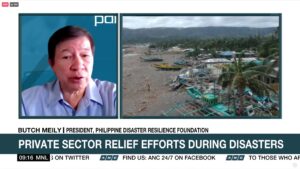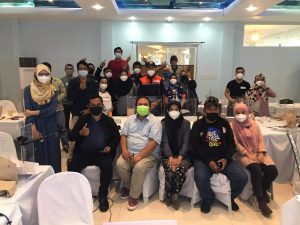Story by Allister Roy Chua | ABS-CBN News
On the day I began writing this, not one, not two, but THREE people I knew passed away within 24 hours of each other – at least one of COVID-19. While the closest of them to me was only as a casual friend, it was nevertheless a heartbreaking moment that drills into you the reality and the gravity of the situation we are facing.
Furthermore, all three were business owners – one the head of a large family company, two startups. In fact, one of the latter had been a merchant enterprise with the Roots Collective in our earlier days, and a then-frequent visitor who always brought so much life into the place. The fact that all three were businesspeople, however, and the fact that our state of calamity has been extended by one year, made one thing eerily clear: it could be me or my partner next. The Roots Collective is currently run by just the two of us, and to have one of us down for even just a short while due to illness is already denting operations badly enough – what more if that downtime were longer or even permanent.
A not-so-rigid backbone
As mentioned in previous articles in this column, most social enterprises are classified as micro, small, and medium enterprises (MSMEs); the British Council estimates this figure to be about 70%. MSMEs also happen to make up 99% of the Philippine economy; and as of 2018, they employed more than 60% of the national workforce.
It goes without saying that MSMEs really constitute the Philippine economy’s backbone and form a vital lifeline to our overall health as a country. Unfortunately, due to a combination of many factors, this backbone is not the most rigid it can be, and is not at peak health: In short, when calamity strikes, we will be left reeling.
Why? Because of the general state of a lack of preparedness among MSMEs to bounce back in the face of disaster, natural or otherwise, and the aftermath thereof.
The house on the rock and the house on sand
According to the 2015 Philippine SME Resilience Survey, only 6% of MSMEs have a written Business Continuity Plan (BCP). A staggering 77% do not, 5% were drafting theirs at the time of surveying, and 12% had no answer. The chief reasons as to why this was the case were the unfamiliarity with BCP as a concept (56%), the lack of information on preparing one (47%), and low awareness of management (28%).
But first, what is BCP?
Business continuity refers to an organization’s ability to continue delivering its products and/or services in an acceptable manner after any kind of disruptive incident. It has legal bases in Republic Acts Nos. 10121, the Philippine Disaster Risk Reduction and Management Act of 2010; and 9501, the Magna Carta for MSMEs. Having a business continuity management system – the management process identifying such disruptive incidents and opportunities leading to them, as well as the framework for strengthening the response thereto – is mandated by ISO 22301:2019. The business continuity plan is the tangible output of such system – an ever-evolving document that serves as a quick reference for all stakeholders.
According to the 2019 World Risk Report, the Philippines is the 9th most at-risk country when it comes to disasters, concluding such based on the exposure to natural calamities, the susceptibility of society to said disasters, its capacity to cope in response to those, and its adaptive capacities. And in the 2015 survey, the top three impacts of disasters on businesses were employees being unable to go to work (67%), the business’s inability to deliver to customers (50%), and damages to facilities and equipment (49%). Without a business continuity plan in place, the risks of these happening when disaster strikes are very high.
In the Gospel according to St. Matthew, Christ spoke of the dichotomy between the wise man who built his house on a rock, and the foolish man who built his house on sand. Having a business continuity plan is like building one’s business on a rock – a storm comes, and it remains standing.
A competitive advantage
Why is business continuity important? Firstly and most obviously, it will help us and our stakeholders stay personally safe when any kind of disruption happens.
It also ensures the overall survivability of the organization. It is a roadmap for them to prepare for, and plan continuing operating under, adverse conditions. It forces them to put these in place, in cold, hard letters, so that key issues can be addressed, and addressed well at that. Being properly trained in the procedures will help us keep cool heads during a crisis to make effective and relevant decisions, minimizing confusion in the process – and by extension minimizing any losses. As such, it would speed up the recovery of critical business functions.
This, thus, makes having a business continuity plan a competitive advantage, as it shows the enterprise has thought ahead and put systems in place to shield itself from risks, meaning it can continue to do business even when things get tough – and deliver to its customers. Some entities have realized the vitality of a BCP to the extent that they may even require it before doing business with.
No better time than now
The COVID-19 pandemic has, of course, been the most serious disruption to businesses and organizations worldwide since perhaps World War II. Many of them, in fact, will not emerge from the pandemic in one piece. Because of how hard we were hit, and considering the still-unstable conditions, we had to let go of our office-warehouse. All inventory is currently stored at my parents’ house where I live – and that has both its rewards and risks.
When we learned about business continuity with the Philippine Disaster Resilience Foundation (PDRF) as a participant in the Social Impact Accelerator of the Innovation for Social Impact Partnership (ISIP) in early 2021, we had to make the draft of our own BCP – even with our very pared back working conditions. As we both work from home, and inventory is right here, we had to treat our homes as for all intents and purposes the Roots Collective offices, and plan accordingly for when disaster strikes in either location.
COVID-19, too, included. We didn’t have a COVID-19 protocol in place – and it was far more crucial for me that we did. If I – knock on wood – ever got COVID-19, we – and the inventory – would be locked down, and deliveries could possibly be forced to be placed on hold. And given that that is our only revenue source, it would essentially spell our doom if that happened.
Even though our BCP showed that most disasters were relatively low-risk for us, the threat of COVID-19 remains high, and it is perhaps the biggest risk of all for us, since we are so lean. It, therefore, provides an even greater sense of urgency that we get our plan up and enacted, and monitor it as much as we do the news. And with COVID-19 here to stay, it will now be a crucial part of our contingency planning if and when we start expanding again.



